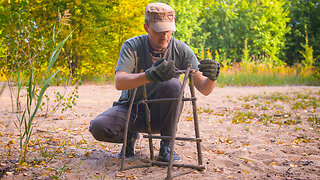Premium Only Content

Lion vs Tiger fight scene video | animals fight scene video | new viral video
Lion vs Tiger fight scene video | animals fight scene video | new viral video
videolink:https://rumble.com/v1lfod1-cute-puppy-pomeranian-hai-cutting-video-cute-puppy-dog-dogs-videos.html
lion, (Panthera leo), large, powerfully built cat (family Felidae) that is second in size only to the tiger. The proverbial “king of beasts,” the lion has been one of the best-known wild animals since earliest times. Lions are most active at night and live in a variety of habitats but prefer grassland, savanna, dense scrub, and open woodland. Historically, they ranged across much of Europe, Asia, and Africa, but now they are found mainly in parts of Africa south of the Sahara. An isolated population of about 650 Asiatic lions constitute a slightly smaller race that lives under strict protection in India’s Gir National Park and Wildlife Sanctuary.
The lion is a well-muscled cat with a long body, large head, and short legs. Size and appearance vary considerably between the sexes. The male’s outstanding characteristic is his mane, which varies between different individuals and populations. It may be entirely lacking; it may fringe the face; or it may be full and shaggy, covering the back of the head, neck, and shoulders and continuing onto the throat and chest to join a fringe along the belly. In some lions the mane and fringe are very dark, almost black, giving the cat a majestic appearance. Manes make males look larger and may serve to intimidate rivals or impress prospective mates. A full-grown male is about 1.8–2.1 metres (6–7 feet) long, excluding the 1-metre tail; he stands about 1.2 metres high at the shoulder and weighs 170–230 kg (370–500 pounds). The female, or lioness, is smaller, with a body length of 1.5 metres, a shoulder height of 0.9–1.1 metres, and a weight of 120–180 kg. The lion’s coat is short and varies in colour from buff yellow, orange-brown, or silvery gray to dark brown, with a tuft on the tail tip that is usually darker than the rest of the coat.
Lions are unique among cats in that they live in a group, or pride. The members of a pride typically spend the day in several scattered groups that may unite to hunt or share a meal. A pride consists of several generations of lionesses, some of which are related, a smaller number of breeding males, and their cubs. The group may consist of as few as 4 or as many as 37 members, but about 15 is the average size. Each pride has a well-defined territory consisting of a core area that is strictly defended against intruding lions and a fringe area where some overlap is tolerated. Where prey is abundant, a territory area may be as small as 20 square km (8 square miles), but if game is sparse, it may cover up to 400 square km. Some prides have been known to use the same territory for decades, passing the area on between females. Lions proclaim their territory by roaring and by scent marking. Their distinctive roar is generally delivered in the evening before a night’s hunting and again before getting up at dawn. Males also proclaim their presence by urinating on bushes, trees, or simply on the ground, leaving a pungent scent behind. Defecation and rubbing against bushes leave different scent markings.
There are a number of competing evolutionary explanations for why lions form groups. Large body size and high density of their main prey probably make group life more efficient for females in terms of energy expenditure. Groups of females, for example, hunt more effectively and are better able to defend cubs against infanticidal males and their hunting territory against other females. The relative importance of these factors is debated, and it is not clear which was responsible for the establishment of group life and which are secondary benefits.
-
 8:36:37
8:36:37
Right Side Broadcasting Network
5 days agoLIVE REPLAY: CPAC 2025 Day Three with President Donald J. Trump - 2/22/25
389K94 -
 1:05:34
1:05:34
The Big Mig™
14 hours agoConfirmed Kash Patel New FBI Director, Bring On The Pain |EP483
88.9K24 -
 53:59
53:59
Tactical Advisor
10 hours agoThe Vault Room Podcast 009 | Everyone Getting $5000?!
63.2K11 -
 2:04:44
2:04:44
TheAlecLaceShow
21 hours agoLive at CPAC | Interviews with Dean Cain, Rep. Comer and more! | The Alec Lace Show
80.9K4 -
 LIVE
LIVE
Major League Fishing
3 days agoLIVE Tackle Warehouse Invitationals, Stop 1, Day 2
426 watching -
 3:12:37
3:12:37
I_Came_With_Fire_Podcast
18 hours agoNOC Spy: CIA uses SATANIC RITUAL ABUSE to make SLEEPER Cells
83.8K18 -
 28:42
28:42
CatfishedOnline
1 day ago $3.55 earnedWoman Insists Morgan Wallen Relationship Isn't a Romance Scam!
62.7K2 -
 16:25
16:25
TSPLY
1 day agoNew CNN / MSNBC Meltdown Moments Of Getting Mad At Donald Trump In February
60.8K31 -
 8:33
8:33
scoutthedoggie
12 hours agoAirsoft War Games Scotland
72.4K7 -
 4:56
4:56
Kirill MultitoolOfficial
1 day ago $4.42 earnedSurvival TIPS and usefull bushcraft DIY in the wild
70.8K5